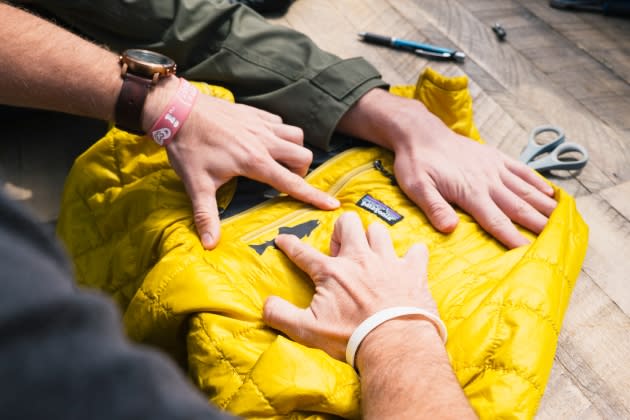Inside Patagonia’s ‘Ironclad’ Repair Philosophy, What’s Next

In three years’ time, Patagonia wants to repair 100,000 items under its ironclad guarantee, which is hard to come by when the product is already designed to last long.
Inclusive of everything the brand makes, if a customer is not satisfied with one of Patagonia’s products at the time of purchase, or if one of its products does not perform to their satisfaction, Patagonia says return it to the store for a repair, replacement or refund. No hard feelings. While mostly a free service, considerable damage due to wear and tear may be repaired at a reasonable fee.
More from WWD
“If you look at Yvon Chouinard, he started with repairing climbing hardware. The DNA of Patagonia is to build the best product. It starts with design. You need to design goods that can be repaired,” Willem Swager, director of finance and operations Europe, Middle East and Africa at Patagonia, told WWD. “I think that is where a lot of other brands and also Patagonia needs to pay attention. If something cannot be repaired, you cannot extend the life. Quality is important. If you wash something three times and it falls apart — there’s nothing to repair.
“The biggest limitation is in people’s minds,” he continued. “We need to change the first reaction when something is broken, so that people can fix it. That’s the biggest one. We will make sure that the repair can be done, and we will do our best to design products that can be repaired, but the consumer is the biggest one we need to convince of keeping their gear in play longer.”
While Patagonia has had a repair philosophy since its inception, its latest United Repair Center buildout in Amsterdam and upcoming initiatives secure repair as a broader appeal to consumers amid an ongoing economic downturn.
In the U.S., the brand has its internal repair team located in Reno, Nevada, helping to perform some 40,000 repairs each year, while its re-commerce operations (like the “Worn Wear” program) are externalized to resale logistics partner Trove outside San Francisco. The repair and resale ability does have some limitations, as “next-to-skin” garments like underwear are off limits in either program, and yoga tops and leggings, T-shirts, shoes, wetsuits, waders and sleeping bags aren’t covered per Worn Wear’s website.
If one’s wears are more worn than expected, repair becomes more limited. If an item is threadbare or counts more than six holes or three broken zippers, Patagonia won’t take it back. Shoes, HydraPaks, delaminated items, pilled fleece, stains, shorts liners, baselayers, tank top or swimsuit straps, socks, gloves, select wheeled luggage and waterproof packs and bags are also out of repair bounds. The brand encourages customers to get in touch or visit one of the many locations if they’re unsure about the potential for repair.
Spanning five repair locations in Portugal, France, Amsterdam, Switzerland and the U.K., Patagonia’s European business — as well as physical repairs in Europe — are taking off. Local is a key strategy for the brand.
“If you look at our strategy going forward, we want to keep repairing locally,” Swager said. “We want to keep the relationship with the customer. In every interaction we have with the customer, we want to activate them to do something for the climate crisis.”
Localized repair is juxtaposed with a global virtual presence.
There’s a host of online resources, be it Patagonia’s care and repair videos, user-contributed guides and provided do-it-yourself repair kits. On iFixit.com, a partner to Patagonia, everything from repairing a ripped seam, spot-washing clothing or patching up holes is available online in a series of 70-plus free iFixit guides. While Patagonia provides its own repair videos, more expansive tutorials are contributed via community forums.
Technical needs, like a water-resistant zipper on a ski jacket, may still be outsourced by Patagonia to a specialist. However, Swager even joked about how his kid’s sweatpants (not Patagonia branded) were repaired by the team in two weeks’ time as a little employee perk.
“I think it’s important for brands to make it easy for customers,” he said, pointing to the accessibility of phone apps for visual-heavy tasks which could provide real-time data on repair status and item tracking. Come October, Patagonia will be rolling out a dedicated European repair website portal that’s in development. The portal, as Swager explained, will help the brand scale repairs across Europe and will likely be rolled out on a “global level.”
As for what’s next, Patagonia’s Black Friday marketing campaigns (like its infamous “Don’t Buy This Jacket”) may feature repair more centrally, as Swager hinted.
Sign up for WWD's Newsletter. For the latest news, follow us on Twitter, Facebook, and Instagram.
